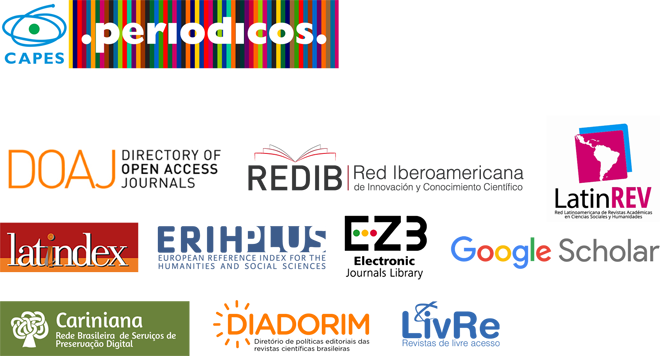The nature experience as an inventiveness process
DOI:
https://doi.org/10.36025/arj.v7i2.19806Keywords:
Art, Experience, Nature, InventivenessAbstract
The article summarizes a research project aimed at the experience of nature as an impulse to creativity. It is reflected here on the relationship with nature, and the experience of direct contact that manifests a potential that symbolic and indirect experiences cannot provide. This direct contact not only strengthens the connection with nature and increases well-being, but also increases curiosity and invention. This research brings together a set of studies that indicate the nature as capable of evoking creative thinking, making a person more flexible in the way they think and more able to get new ideas. In addition, it helps in the restoration of focused attention, fundamental in the evaluation, and evolution of ideas. Finally, artistic practices are mentioned that ground this issue of nature as a creative promoter.
Downloads
References
AMARANTE [Câmara Municipal de Amarante]. Alberto Carneiro: Grande Prémio Amadeu de Sousa-Cardoso. [S. l.], 2015.
ATCHLEY, Ruth Ann; STRAYER, David L.; ATCHLEY, Paul. Creativity in the Wild: Improving Creative Reasoning through Immersion in Natural Settings. PLoS ONE, 7(12), p. 10-13, 2012.
BAI, Heesoon; ELZA, Daniela; KOVACS, Peter; ROMANYCIA, Serenna. Re?searching and re?storying the complex and complicated relationship of biophilia and bibliophilia Re-searching and Re-storying the Complex and Complicated Relationship of Biophilia and Bibliophilia. Environmental Education Research, [s. l.], 16(3), 351-365, 2010. Disponível em: https://www.researchgate.net/publication/248965513_Re-searching_and_re-storying_the_complex_and_complicated_relationship_of_biophilia_and_bibliophilia
BANNING, Wendy; SULLIVAN, Ginny. Lens on Outdoor Learning. St. Paul, MN: Readleaf Press, 2010.
FERRARO III, Frank M. Enhancement of Convergent Creativity Following a Multiday Wilderness Experience. Ecopsycologie, [s. l.], v. 7, n. 1, p. 7-11, Mar. 2015.
FINCH, Ken; BAILIE, Patti Ensel. Nature Preschools: Putting Nature at the Heart of Early Childhood. Occasional Paper Series, [s. l.], n. 33, 2015
GRANDE, John K. Art nature dialogues: interviews with environmental artists. New York: State University of New York, 2004.
KELLERT, Stephen R. Nature and Childhood Development. In: Building for Life: Designing and Understanding the Human-Nature Connection. London: Island Press, 2005.
LONG, Richard. Walking in circles. London: [s. n.], 1994.
MEDNICK, Sarnoff. The associative basis of the creative process. Psychological Review, [s. l.], v. 69, n. 3, p. 220–232, 1962.
MODESTO, Filipa. A osteologia na arquitectura de Gaudí: Casa Battló, Casa Milá, Parque Guëll, Colonia Guëll e Sagrada Família. 2014. Dissertação (Mestrado em Anatomia Artística) – Faculdade de Belas-Artes, Universidade de Lisboa, [s. l.], 2014.
PLAMBECH, Trine; VAN DEN BOSCH, Cecil C. Konijnendijk. The impact of nature on creativity – A study among Danish creative professionals. Urban Forestry & Urban Greening, [s. l.], v. 14, n. 2, p. 255-263, 2015. Disponível em: http://dx.doi.org/10.1016/j.ufug.2015.02.006.
SCHIAVONE, Theresa. Grand Canyon Suite. [s. l.], 2000. Disponível em: https://www.npr.org/2000/10/29/1113160/grand-canyon-suite?t=1579090605880&t=1579177828724.
SIC NOTÍCIAS. Estudo prova que passar quatro dias na natureza sem tecnologias aumenta a criatividade em 50%. [s. l.], 2012. Disponível em: https://sicnoticias.pt/vida/2012-12-12-estudo-prova-que-passar-quatro-dias-na-natureza-sem-tecnologias-aumenta-criatividade-em-50.
TOVEY, Helen. Playing Outdoors: Spaces and Places, Risk and Challenge. Maidenhead, England: Open University Press, 2007.
WHITE, Randy. Young Children’s Relationship with Nature: Its Importance to Children’s Development & the Earth’s Future. [S. l.]: White Hutchinson, 2004. Disponível em: https://www.whitehutchinson.com/children/articles/childrennature.shtml. Acesso em: 25 Out. 2020.
Downloads
Published
How to Cite
Issue
Section
License
Copyright (c) 2020 Sabina Couto, Domingos Loureiro (Autor)

This work is licensed under a Creative Commons Attribution-NonCommercial-ShareAlike 4.0 International License.

This work is licensed under a Attribution-NonCommercial-ShareAlike 4.0 International (CC BY-NC-SA 4.0) License.
Authors retain copyright, while licensing their work under a Attribution-NonCommercial-ShareAlike 4.0 International (CC BY-NC-SA 4.0) License.


 English
English Português (Brasil)
Português (Brasil)
